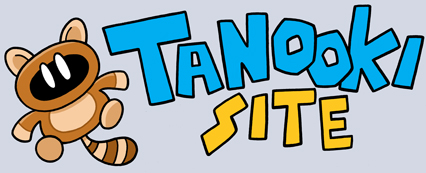Nintendo’s Era of Censorship
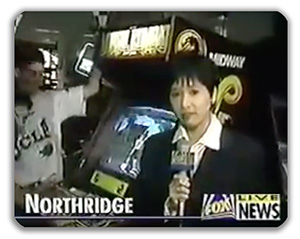
As video games grew in popularity, so did moral panic over their content. Nintendo tired to appease anxious parents.
It was sometime between the late 1980s and the mid-1990s. Video games were enjoying their great second wind in the United States, and a single corporation — Nintendo — dominated the market.
All the popular video game systems were made by Nintendo. The game-making software was owned by Nintendo. Every game on store shelves had to be licensed by Nintendo. It was a smothering dominance that seemed to border on the monopolistic, and indeed, Nintendo was repeatedly taken to court during the era for precisely that offense.
Whatever we think of the “Nintendo Age” in retrospect (and many don’t think much), it undeniably left a lasting mark on American gaming — as monopolies are wont to do.
Well aware that many American parents of the time considered video games a sinister, youth-corrupting force, during its epoch of influence Nintendo of America (NOA) made it a corporate priority to force all games published under its banner to contain only “family friendly” themes and content. Though relatively uncontroversial with consumers of the time, this moralistic pushiness has risen to become one of NOA’s most infamous legacies, as attitudes towards concepts like artistic freedom swing in a more permissive, less judgmental direction.
Old video games are now widely downloaded and shared illegally online, including original Japanese editions that were never released in America. The sheer degree to which NOA actively censored and softened the content of games imported from Japan has become well-known, and a frequent topic of outraged online chatter. “Offensive” Japanese content from dozens of imported games — including many bestsellers — was removed, edited, or bowdlerized, all in the name of a very conservative, Reagan-era standard of decency. References to smoking or sex were cut, beer bottles were changed to coffee cups, spurts of blood softened into blobs of sweat, and so forth. Games with even more offensive content may simply have not been released at all. To 21st century eyes, much of this censorship now seems quite dated or condescending, particularly from the perspective of Millennial gamers capable of reflecting on their childhood authority figures with a new, more critical perspective.
The Rules
Though it’s popular to denounce Nintendo’s past-decade censorship practices as arbitrary or inconsistent, it was actually quite methodical.
What follows is the full text of “Nintendo of America’s Video Game Content Guidelines,” as quoted in an otherwise forgettable 1994 book, The Parent’s Guide to Video Games, by Steven and Janet Schwartz. This is the document that provided the ground rules governing the entire NOA censorship regime.
Nintendo of America’s Video Game Content Guidelines
[circa 1994]
Nintendo of America’s priority is to deliver high quality video game entertainment for our customers. When those customers are children, parental involvement in their game playing is recommended. Nintendo is concerned that our products do not contain material that society as a whole deems unacceptable.
Consequently, since 1988 we have consistently tested the content of all games developed for Nintendo systems against our evolving game standards. As our business has matured, we have adapted our guidelines to meet the concerns of the members of our target age group and their parents. Although we realize that definitions of social, cultural and political views are highly subjective, we will continue to provide consumers with entertainment that reflects the acceptable norms of society.
The following Game Content Guidelines are presented for assistance in the development of authorized game paks (i.e., both Nintendo and licensee game paks) by defining the type of content and themes inconsistent with Nintendo’s corporate and marketing philosophy. Although exceptions may be made to preserve the content of a game, Nintendo will not approve games for the NES, Game Boy or Super NES systems (i.e., audio-visual work, packaging, and instruction manuals) which:
• include sexually suggestive or explicit content including rape and/or nudity; [1]
• contain language or depiction which specifically denigrates members of either sex; [2]
• depict random, gratuitous, and/or excessive violence; [3]
• depict graphic illustration of death; [4]
• depict domestic violence and/or abuse; [5]
• depict excessive force in a sports game beyond what is inherent in actual contact sports; [6]
• reflect ethnic, religious, nationalistic, or sexual stereotypes of language; this includes symbols that are related to any type of racial, religious, nationalistic, or ethnic group, such as crosses, pentagrams, God, Gods (Roman mythological gods are acceptable), Satan, hell, Buddha; [7]
• use profanity or obscenity in any form or incorporate language or gestures that could be offensive by prevailing public standards and tastes; [8]
• incorporate or encourage the use of illegal drugs, smoking materials, and/or alcohol (Nintendo does not allow a beer or cigarette ad to be placed on an arena, stadium or playing field wall, or fence in a sports game); [9]
• include subliminal political messages or overt political statements [10]
Annotations:
Virtually every one of the above rules was evoked by NOA at some time or another for the purposes of censoring some content in some game at some time.
I have annotated the above policy guidelines with a series of examples showing how exactly these rules were commonly applied in practice. My examples are nowhere near exhaustive, but are still hopefully representative of general techniques. This is a topic many have written about at length, however, and for those interested, the links at the end of this essay should offer no shortage of alternative examples.
Rule 1: “Nintendo will not approve games which … include sexually suggestive or explicit content including rape and/or nudity”
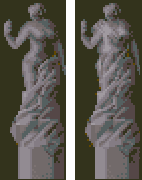
This nude statue in Super Castlevania IV (1991) was “clothed” in the U.S. release (right).
As any fan of Japanese pop culture can attest, the Japanese tend to be fairly liberal when it comes to depictions of nudity, sex, and all things titillating. This, coupled with the fact that video games in Japan are generally as popular with adult men as children, resulted in no shortage of games requiring their sexiness to be significantly toned down prior to U.S. release.
Game characters that appeared nude (or simply wore excessively revealing outfits) in Japanese titles were usually clothed by NOA, and even the so-called “tasteful nudity” of classical artwork and the like was rarely allowed.
Sex and sex acts were obviously not permitted to be performed, mentioned, or alluded to. Character dialogue that alluded to rape, prostitution, adultery, or homosexuality were deleted, and double entendres were usually retooled into far less risque gags.
Rule 2: “Nintendo will not approve games which … contain language or depictions which specifically denigrates members of either sex”

In the Japanese version of Lufia II: Rise of the Sinistrals (1995), the women working at the casino are depicted as Playboy bunnies (left). They are dressed more conservatively in the American version (right).
While Nintendo of America didn’t exactly lead a full-force rebellion against sexism in video games, there were a number of occasions when NOA brought down the hammer on titles whose depictions of females were deemed to cross the line between “sexualized” and “denigrating.” Scantily-clad female characters were often forced to “covered up” prior to their appearance in an American release, sexist nicknames or slurs were removed from dialogue, and in some cases, female enemy characters in violent games were even replaced by male substitutes, lest American gamers be subjected to the ultimate taboo of man-on-woman violence.
Again, much of the disputed content had its roots in Japanese cultural differences regarding gender relations. Japan in general possesses a far stronger culture of male chauvinism than America, and to this day Japanese society does not react nearly as negatively to sexualized or passive depictions of women in the media.
Rule 3: “Nintendo will not approve games which … depict random, gratuitous, and/or excessive violence”
Though it may sound impossibly maudlin by today’s standards, NOA originally had strict guidelines regarding what were and were not “acceptable” forms of video game violence. Essentially, violent acts had to be committed in a proper context against a proper opponent. Sword and knife play was allowed, but only against equally well-armed opponents. Civilian or friendly characters could not be attacked, nor could innocent animals. In most cases, guns could only be used against robots or other non-human creatures, such as aliens or zombies.

A somewhat obtuse explanation for what a 1-Up does from the Mega Man 2 (1989) instruction booklet.
The on-screen consequences of violence were also required to be stylized and inoffensive. When bad guys perished, their corpses had to vanish quickly, not accumulate into festering piles. The implication was that these characters were not really “dead” but were simply being “eliminated” from the game’s universe in the same way pawns are eliminated from a chess board.
This synced with NOA’s other policy regarding death in games, namely that the words “death,” “die,” “kill,” or “killed” were never to be used. Nintendo game manuals and in-game dialogue of the time never made reference to the “killing” of enemies, but rather their “defeat” or “destruction.” Though players referred to their character’s number of “lives,” official game text referred to these as “tries” or “chances.”
Rule 4: “Nintendo will not approve games which … depict graphic illustration of death”
There was to be no gore in Nintendo games. If a character was shot, blood could not spew from his torso, nor could guts fly out, or anything of that nature.
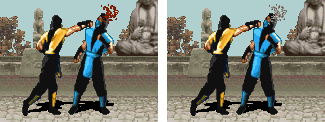
From blood to “sweat” in Mortal Kombat.
This strict “no blood” policy came to an embarrassing climax following the 1992 release of Mortal Kombat for the SNES. In the arcade edition, Mortal Kombat made headlines as one of the most explicitly vicious games ever released, giving players the the ability to rip out their opponent’s spinal cord, tear pulsating organs from their chest, and all the rest of it. Far from being a turn-off to game players, such gruesomeness made the title a smash hit.
When the game was ported to the SNES later that year, however, gamers were disappointed to find that Nintendo had edited out nearly all of the gore. Instead of blood, gray blobs of “sweat” flew from the characters’ bodies, and the hideously creative “fatality” moves had been removed entirely. The game was a commercial flop, especially compared to the success of the uncensored version available on the Sega Genesis — by then NOA’s lead competitor in console gaming. The incident is credited with triggering a conveniently-timed relaxation of Nintendo’s attitudes towards video game violence.
Rule 5: “Nintendo will not approve games which … depict domestic violence and/or abuse”
There is generally not a whole lot of domestic violence in video games, due to the simple fact that most video games don’t take place in a domestic setting. But it did come up once in a while.
At one point in the Japanese role-playing game Mother 2 (1994), a father character punishes his children for coming home late. He takes them off-screen, and a “beating” noise is heard. If you talk to one of the kids afterwards, he complains his “butt hurts.” When Mother 2 was released in America (under the name Earthbound (1995)), the beating sound was changed to the game’s “scolding” noise. Instead of complaining about his butt, the kid now whines that dad took away his dessert privileges. A full compare-and-contrast YouTube video can be seen here.
Rule 6: “Nintendo will not approve games which … depict excessive force in a sports game…”
Most sports games are made in the United States, and during the era in question, sports games were thus almost certainly developed with NOA rules in mind. I am unaware of the existence of any sports game being censored because of “excessive force.”
Rule 7: “Nintendo will not approve games which … reflect ethnic, religious, nationalistic, or sexual stereotypes of language…”
This is an interesting one, and was apparently intended to prevent NOA-approved video games from using racist, cultural, or sexist slurs, which is what academics usually understand the phrase “stereotypes of language” to mean.
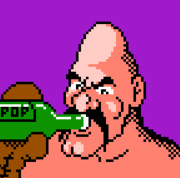
A typical Russian? Vodka Drunkenski from Punch-Out!!.
It’s hard to find many overt instances of this rule being invoked, since most purging of bigoted language from Japanese games (if it ever, in fact occurred) presumably took place during the Japanese-to-English translation process, which is not terribly easy for Japanese illiterates like myself to investigate.
One possible example might be the renaming of the Russian character in Punch-Out!! (1984) from “Vodka Drunkenski” to “Soda Popinski” when the game was brought to America. Although it seems clear that the primary motivation for this change was Rule 9, which forbid liquor references, it’s also possible the new name was at least partially motivated by a desire to tone down the character’s image as a stereotypical “Russian drunk.”
“… symbols that are related to any type of racial, religious, nationalistic, or ethnic group…”
Here we get into some of the most widely invoked NOA rules, and thus the most infamous. Since the latter part of Rule 7 dealt with the management of potentially offensive imagery, instances of this rule’s employ will be immediately obvious to anyone who has played both the Japanese and American versions of a censored game.
“… such as crosses…”
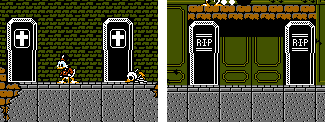
The crosses on the tombstones in DuckTales (1989) were changed to “RIP” for the U.S. release.
Against the backdrop of today’s endless culture wars about keeping “Christ in Christmas” and so forth, it seems quaint to remember that there was a time when keeping Christianity out of the vulgar popular culture was a popular conservative stance. NOA’s aggressive efforts to remove crosses from video games remains a charming testament.
During the censorship era, in-game depictions of cross-shaped tombstones, cross-topped churches, cross-covered Bibles, and cross-shaped pendant jewelry all had to be removed prior to U.S. release, causing a lot of awkwardly vacant steeples and cemeteries for American gamers. Even in the vampire-themed Castlevania franchise (1987 – ), clever editing ensured that the hero used boomerangs, rather than crosses to kill Dracula.
It’s sometimes believed that this cross-phobia was also the reason why Japanese depictions of the Red Cross on in-game first aid kits and hospitals were usually removed prior to American release, though in reality copyright issues with this internationally-trademarked logo are a more likely explanation.
“… God, Gods… Satan, hell…”
Other religiously-inspired names had to be toned down as well. In Final Fantasy III (1994) the “Holy” magic spell was given the blander name, “Pearl.”
Devils were permitted to appear in Nintendo games, but were not allowed to be referred to as such. Horned creatures were always given names such as “imps” or “demons,” and even the recurring “Yellow Devil” character in the Mega Man franchise (1987 – ) was renamed the “Rock Monster,” despite the fact that he bore no resemblance to a traditional Christian devil (or a monster made of rocks, for that matter). In Secret of Mana (1993), the “Hell Hound” character was rather ostentatiously renamed “Heck Hound” for the U.S. release.
“… symbols that are related to any type of … nationalistic, or ethnic group…”
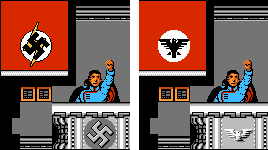
The swastikas on the Nazi flags in Bionic Commando were changed to equally Germanic eagles.
Several popular American titles were originally supposed to feature everyone’s favorite bad guys, Nazis, in the villain role, but history’s most virulent Aryan supremacists were not welcome so long as NOA desired their games to be free of overtly distasteful ethno-nationalism. Even if a game used Nazis in a historical setting or context, the party swastika was not permitted to be shown. Nor Adolph Hitler himself, for that matter.
The NES game Bionic Commando (1988) had a very different start in Japan, where it was called Top Secret: The Resurrection of Hitler (1988). Originally, the game’s plot centered around a group of Neo-Nazis trying to resurrect Hitler as part of some sinister plan for global domination. When the game came to America, the basic plot stayed the same except Nazis became “the Badds” and Hitler became “Master D.” Swastikas were edited out, but Hitler’s appearance remained unchanged.
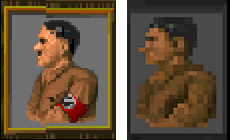
A Hitler poster in the PC version (left) versus a poster of the “Staatsmeister” in the SNES version (right) of Wolfenstein 3D.
Wolfenstein 3D (1992) was a popular first-person shooter for the PC. You control some manner of Jewish vigilante-type through a castle full of Nazis, eventually doing battle with the Führer himself. These Nazi references were all carefully edited for the SNES port. Hitler became the “Staatmeister” and all swastikas were deleted, creating a considerably less foreboding castle full of plain red flags.
Rule 8: “Nintendo will not approve games which … use profanity or obscenity in any form…”
NOA’s decision to ban swearing from games was probably among its least controversial censorship policies and was not often employed. This is in part because the old trope about the Japanese being too polite to even have swear words has some truth to it. As blogger-translator extraordinaire Clyde Mandelin notes in a post on this topic, the Japanese language is governed by elaborate class-based speech codes, such that speaking to someone in the tense reserved for those of the lowest social standing “is the closest equivalent to our swearing.” This, needless to say, did not provide much of a minefield for NOA to navigate.
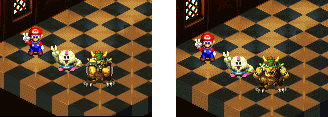
Bowser’s offensive “winning pose” — which resembles the popular European “up yours” gesture (left) — was changed for the American version (right) of Super Mario RPG (1996).
If anyone was creating brazenly profane content, it was the Americans themselves. The original Who Framed Roger Rabbit (1998) film, for instance, features a bad guy named “Smart Ass.” In the NES game adaptation he was renamed “Smarty.”
Obscene acts were slightly more common, and there are a few documented instances of raised middle fingers or other rude gestures being removed from gameplay.
Rule 9: “Nintendo will not approve games which … incorporate or encourage the use of illegal drugs, smoking materials, and/or alcohol”

The various bars in Japan’s Final Fantasy VI (1994) were changed to “cafes” in the American version, known as Final Fantasy III.
Even in Japan, rampant use of illegal drugs is not exactly common in video games. I’ve only been able to find one instance of note: in the original version of Final Fantasy Legend II (1990) there is a criminal gang smuggling opium. In the American version (1991), they’re smuggling bananas. Just as evil, I suppose.
Far more common was NOA’s crackdown on the in-game appearance of legal drugs, namely tobacco and alcohol. Prior to U.S. release, smoking characters’ cigarettes or cigars were edited out, while cans of beer or glasses of wine were eliminated or softened into something innocent, like soda or coffee.
Japanese games, likewise, frequently featured “bar” settings which had to be modified into cafes or diners.
Rule 10: “Nintendo will not approve games which … include subliminal political messages or overt political statements”
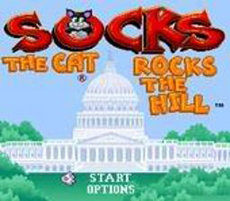
Socks the Cat Rocks the Hill remains one of the most mysterious and elusive never-published video games of the late 1990s.
Perhaps the least-invoked rule, next to the sports one. It’s not a stretch to assume that most 1980s-era Japanese video game programmers lacked either the knowledge or interest in American political culture to include “subliminal” political messages in their games — let alone overt ones — that would affect U.S. audiences.
In an earlier version of this essay, I floated the idea that a never-released, mid-1990s SNES title, Socks the Cat Rocks the Hill (circa 1994), might have been canned due to the fact that it contained, by some accounts, fairly mean-spirited caricatures of contemporary American political figures in villainous roles. Rumours of content-related cancellation have since been denied by individuals involved in the game’s development, though if there was ever a game to push the limits of this rule, Socks was probably it. Interestingly enough, Nintendo did assent to the American release of a game called I’m Sorry (1985) that gently satirized the supposedly kleptocratic tendencies of former Japanese prime minister Tanaka Kakuei (1918-1993).
Epilogue
By the mid-’90s, Nintendo’s censorship practices were becoming both an embarrassment and a financial liability. Nintendo was earning a reputation as a “kiddy” company that was too patronizing and immature for older gamers — at precisely the time when an aging consumer base was putting “mature” games in much higher demand.
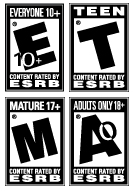
ESRB ratings symbols.
A blessing of sorts came in 1994, when the Entertainment Software Rating Board (ESRB) was established. Founded and run by leading representatives of the video game industry itself, the ESRB represented an effort to self-impose a single uniform ratings system upon the entire American gaming market. Such a pre-emptive gesture of corporate responsibility was intended to help stave off the looming threat of more oppressive government regulation at a time when youth media censorship was becoming a bipartisan cause, led by politicians like Senator Joseph Lieberman (D-CT).
Beginning in 1996, every video game title produced for any video game system (not just Nintendo’s) agreed to undergo content assessment by the ESRB and receive a rating prior to its commercial release. A “K-A” rating would signify a game was appropriate for all ages, “T” would mean it was for teens 13 and older, and “M” would mean it was intended for adults. The ratings were awarded based on an independent panel’s analysis of content such as violence, profanity, and sexualized imagery, and was similar to the process used to rate American movies.
The ESRB system allowed NOA to gradually relax its censorship practices on the grounds they could legitimately argue that their games were being targeted to specific age groups, rather than a more generalized market. Today, Nintendo of America does not actively censor the games released on their systems, and it is up to individual software companies to sink or swim in the marketplace based on their ESRB ratings.
In 2011, the Supreme Court of the United States ruled 7-to-2 in the case of Brown v. Entertainment Merchants Association that it was unconstitutional for states to impose laws banning the sale of “mature” games to children who wanted them. The decision greatly watered-down the relevance of ESRB ratings (or any other video game content rating regime) since the Court found such ratings cannot be used as grounds for denying consumer access. They remain merely advisory.
Links
- Inappropriate Content: A Brief History of Videogame Ratings and the ESRB, Escapist.org (2007)
- Legends of Localization, a website by translator Clyde Mandelin devoted to “looking at how various video games have changed during the translation and localization process.”
- The Expurgation of Maniac Mansion for the Nintendo Entertainment System, a famous essay by Douglas Crockford, an American software developer, about his experiences dealing with NOA censors in 1990.
